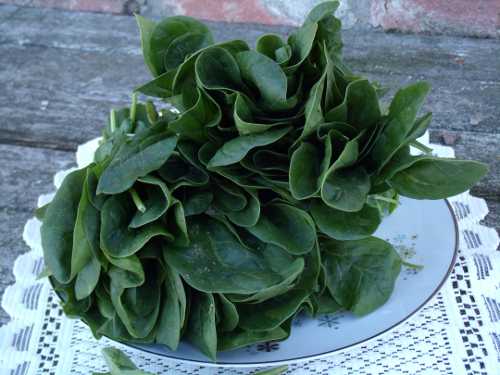
I was fascinated by Popeye the Sailor’s spinach-loving persona as a child. This classic cartoon character downed a can of spinach for its nutritional kick whenever he needed a dose of strength.
Popeye may have done more for the reputation of this veggie than dozens of marketing campaigns since.
With all respect to Popeye, I’m not sure canned spinach is the wisest culinary choice. If you’ve ever tasted it, you’ll know why spinach got a bad flavor rap. Fresh spinach, as well as frozen, is a completely different animal.
Beautiful, bright green spinach is amazingly versatile. Fresh or frozen, I throw it into almost everything – sauces, soups, pasta, salads and egg dishes such as omelets, quiches and frittatas – for flavor, color and an extra boost of nutrition.
I find that it’s a simple way to sneak something healthy into everyday meals.
Spinach is a member of an interestingly named family of plants called “goosefoot” after the shape of the leaves, which resemble the feet of this fowl.
It’s related to amaranth, a genus of plants that includes the ancient high-protein grain native to South America.
Spinach originated in ancient Persia, which includes modern-day Iran, and wild species are still extant there, growing throughout the country.
Arab traders introduced it to India, where it remains popular today. From there it made its way to seventh century China, a gift from the king of Nepal. In China it was known as “Persia vegetable.”
Spinach has a much more recent history in Europe than many other vegetables, not appearing there until the 11th century, when the Moors introduced it to Spain.
Just as it was known as “Persia vegetable” in China, it was known as “the Spanish vegetable” after it made its way to England. It appeared in Britain’s first cookbook, the Forme of Cury, which was published in 1390.
There are three main varieties of spinach. Flat or smooth-leaved spinach is most common, sold in markets and used in products made with spinach.
Savoy spinach has dark green, curly leaves. Semi-savoy, as its name implies, has leaves that are less curly than savoy spinach.
I made a tasty spinach salad last night with sliced mushrooms, Gorgonzola cheese, dried cranberries and toasted hazelnuts and served it with a balsamic-olive oil vinaigrette.
Other nice additions to a spinach salad are chopped hard-cooked eggs, thinly sliced red onions (soak them in cold water for 10 – 20 minutes first to mellow their flavor), walnuts or pecans, and the classic ingredient for a spinach salad, crumbled bacon.
I enjoy mixing fresh or thawed frozen spinach into ricotta cheese as a filling for lasagna, and I finely chop it to add to spaghetti sauce or rice in the last stages of cooking.
It’s a mouth-watering companion for mushrooms and shallots in omelets, and it’s a favorite for me with a Swiss cheese in frittatas and quiches.
Spinach may be steamed or boiled as a simple side dish. It’s lovely with a squeeze of lemon and, if you wish, a dollop of sweet butter. Some people shake a little vinegar over it, usually the red wine or malt variety, but this has never caught on with me.
Spinach shrinks by an amazing 90 percent when cooked. One pound of fresh spinach equals about 10 cups; however, when cooked, the same 10 cups of spinach becomes roughly one and a half cups. This should be taken into consideration when serving it as a side dish.
When choosing spinach, look for bunches with vibrant, deep green leaves and stems with no signs of yellowing. The leaves should look fresh and tender, and not be wilted, bruised, or with a slimy coating, as this is an indication of decay.
The sandy soil in which spinach is grown will often cling to the leaves, so a thorough washing is necessary. I usually soak spinach in a large bowl filled with cold water, pull it out, rinse the bowl, and soak it again as often as needed.
Once there is no dirt settled to the bottom of the bowl, the spinach is clean.
If spinach has been grown hydroponically (and it often is these days), it won’t have dirt layered in its leaves.
It’s recommended that spinach not be washed prior to storing as it will spoil more quickly. It’s best stored in a plastic bag with as much of the air squeezed out as possible.
Spinach is a nutrient dense food. Like other dark leafy greens, the nutritional benefit per calorie is the highest in the vegetable kingdom.
It’s extremely high in antioxidants, especially when fresh, steamed or quickly boiled, and rich in vitamin A (and especially high in lutein), as well as vitamins C, E and K.
It contains stores of magnesium, manganese, folate, iron, vitamin B2, calcium, potassium, vitamin B6, folic acid, copper, protein, phosphorus, zinc, niacin, selenium and omega-3 fatty acids.
In addition to all this, it contains a high level of iron. Because of the oxalic acid in spinach, however, our bodies may have difficulty absorbing the iron and calcium in spinach.
This may be remedied by consuming spinach with a food high in vitamin C, such as tomatoes or citrus fruits. For example, add tomatoes to your spinach salad or omelet or down a glass of orange juice when eating spinach-filled dishes.
Gremolata, a mixture of lemon zest, garlic and parsley – ingredients high in vitamin C - is delicious when mixed in with cooked spinach.
Today’s recipe is a classic and a favorite of many, including me: creamed spinach. I’ve combined the best of a number of recipes to come up with my own version.
The recipe includes heavy cream, so if a lower fat version is desired, substitute whole or 2 percent milk. Low-fat evaporated milk may also be used.
Before I go, have you ever wondered why Eggs Benedict served with spinach in place of ham is called Eggs Florentine? It stems from a centuries old royal marriage.
In 1533, Catherine de’ Medici left her native Florence to marry the king of France. She brought her own cooks with her so they could prepare her favorite vegetable, spinach, in a variety of ways. The tradition of calling dishes on a bed of spinach “Florentine” stems from her enthusiasm for it carried from her Italian hometown.
And finally, if you’re watching the Super Bowl today, perhaps a hearty spinach dip is in order.
Bon appétit!
Esther’s creamed spinach
2 bunches fresh spinach, washed, stemmed and chopped
2 tablespoons sweet butter
1 tablespoon olive oil
1 white or yellow onion, finely chopped (if a sweet variety is available, all the better)
1 – 2 cloves garlic, minced
¼ teaspoon fresh nutmeg (more to taste)
Salt and freshly ground pepper to taste
¼ cup heavy cream
Melt butter in a pan; add olive oil.
Sauté onion for several minutes in butter and olive oil until softened. Add garlic and sauté for a minute or so more, being careful not to scorch it.
Add the chopped spinach and warm through, allowing it to wilt a bit.
Add the salt, pepper, nutmeg and heavy cream and mix well.
Cook until the liquid has reduced by half and spinach is cooked through.
Esther Oertel, a freelance writer, cooking teacher, and speaker, is passionate about local produce and all foods in the vegetable kingdom. She welcomes your questions and comments and may be reached at This email address is being protected from spambots. You need JavaScript enabled to view it.">This email address is being protected from spambots. You need JavaScript enabled to view it..
Follow Lake County News on Twitter at http://twitter.com/LakeCoNews, on Tumblr at www.lakeconews.tumblr.com, on Google+, on Facebook at www.facebook.com/pages/Lake-County-News/143156775604?ref=mf and on YouTube at www.youtube.com/user/LakeCoNews .

 How to resolve AdBlock issue?
How to resolve AdBlock issue? 



























